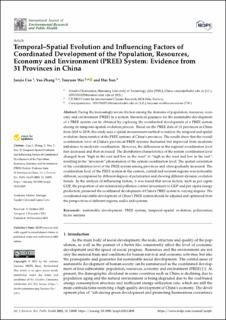| dc.contributor.author | Cao, Junjie | |
| dc.contributor.author | Zhang, Yao | |
| dc.contributor.author | Wei, Taoyuan | |
| dc.contributor.author | Sun, Hui | |
| dc.date.accessioned | 2022-04-26T12:50:06Z | |
| dc.date.available | 2022-04-26T12:50:06Z | |
| dc.date.created | 2022-02-09T23:10:49Z | |
| dc.date.issued | 2021 | |
| dc.identifier.citation | International Journal of Environmental Research and Public Health (IJERPH). 2021, 18 (24), 1-22. | en_US |
| dc.identifier.issn | 1661-7827 | |
| dc.identifier.uri | https://hdl.handle.net/11250/2992871 | |
| dc.description.abstract | Facing the increasingly severe friction among the domains of population, resources, economy and environment (PREE) in a system, theoretical guidance for the sustainable development of a PREE system can be obtained by exploring the coordinated development of a PREE system during its temporal–spatial evolution process. Based on the PREE data of 31 provinces in China from 2010 to 2019, this study uses a spatial measurement method to analyze the temporal and spatial evolution characteristics of the PREE systems of China’s provinces. The results show that the overall coordination level of China’s provincial PREE systems fluctuated but improved from moderate imbalance to moderate coordination. However, the differences in the regional coordination level first decreased and then increased. The distribution characteristics of the system coordination level changed from “high in the east and low in the west” to “high in the west and low in the east”,resulting in the “inversion” phenomenon of the system coordination level. The spatial correlationof the coordination level of the PREE system among provinces and cities gradually increased. The coordination level of the PREE system in the eastern, central and western regions was noticeably different, accompanied by different degrees of polarization and showing different dynamic evolution trends. In the analysis of influencing factors, it was found that seven factors, such as per capita GDP, the proportion of environmental pollution control investment to GDP and per capita energy production, promoted the coordinated development of China’s PREE system to varying degrees. The coordinated and stable development of China’s PREE system should be adjusted and optimized from the perspectives of different regions, scales and systems. | en_US |
| dc.language.iso | eng | en_US |
| dc.publisher | MDPI | en_US |
| dc.rights | Navngivelse 4.0 Internasjonal | * |
| dc.rights.uri | http://creativecommons.org/licenses/by/4.0/deed.no | * |
| dc.subject | sustainable development | en_US |
| dc.subject | PREE system | en_US |
| dc.subject | temporal–spatial evolution | en_US |
| dc.subject | polarization | en_US |
| dc.subject | factor analysis | en_US |
| dc.title | Temporal–spatial evolution and influencing factors of coordinated development of the population, resources, economy and environment (Pree) system: Evidence from 31 provinces in China | en_US |
| dc.type | Journal article | en_US |
| dc.type | Peer reviewed | en_US |
| dc.description.version | publishedVersion | en_US |
| dc.source.pagenumber | 1-22 | en_US |
| dc.source.volume | 18 | en_US |
| dc.source.journal | International Journal of Environmental Research and Public Health (IJERPH) | en_US |
| dc.source.issue | 24 | en_US |
| dc.identifier.doi | 10.3390/ijerph182413049 | |
| dc.identifier.cristin | 1999750 | |
| cristin.ispublished | true | |
| cristin.fulltext | original | |
| cristin.qualitycode | 1 | |

